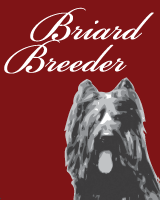|
|
|
|
| |
|
Briard info |
|
Let's
Talk Briards
Yes. I still
want a Briard. What now?
Briards of the past.. |
Dog Safety
- An Ongoing Job
Understanding and Maintaining Pack Order
Show Dog? American and French Championship
requirements.... |
|
|
|
Let's talk
Briards |
|
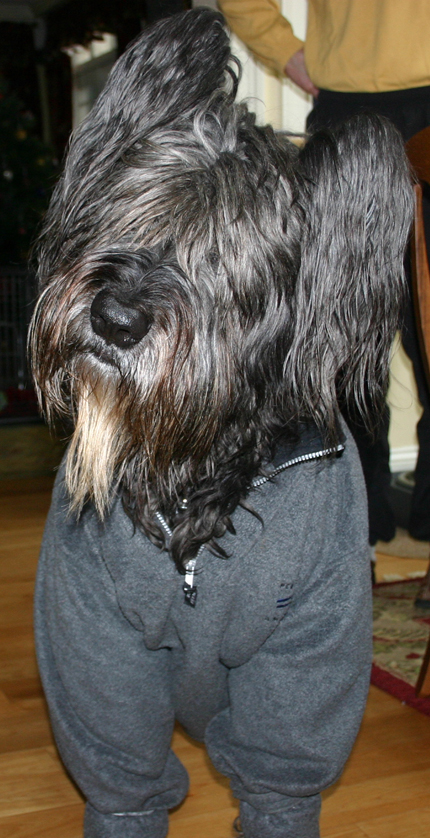
Let's talk Briards
Written by Olga Shulman with
edits by Liz Kenitz
Many people are attracted to these cute fluffy
dogs who often
look more like large goofy toys than serious athletic dogs with teeth.
They are great and we love them, but these dogs are not for
everyone...
So,
before you decide that you want to share your life with one -
let's talk about what you are getting into..
A
Briard is said to be loyal and intelligent. Almost every article
you read will tell you that this is a 'heart wrapped in fur',
but what does that mean in every day life? Where is the answer?
What
do you imagine when you see the words: loyal and intelligent?
Most
people I asked imagine something between the characters of
'Lassie' and 'Lady and the Tramp'. They see cuddling with them
on a lazy Sunday afternoon, taking them to doggy playgrounds
where dogs happily chase balls with others. They see fearless
protectors when occasion calls.... The pictures they paint are
always idyllic....
They
see themselves loving much of what they think these dogs can give...
Unfortunately people often do not see what they themselves must
give in return and how much work it really is to own one of
these furry hearts.
So
let's look into that... |
|
|
|
Temperament
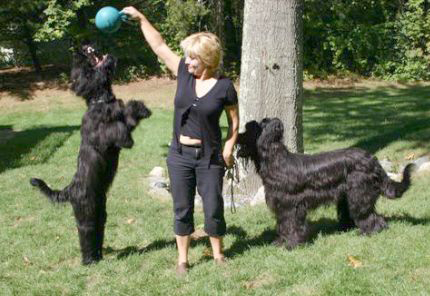
Yes these
dogs are loyal and intelligent. But what does it mean?
For centuries
these types of dogs were bred to work on farms and help
shepherds guard and move flocks of sheep. They were selected for
their ability to work independently and think for themselves
even while under the direction of the shepherd. They were also
selected for their ability to please their master by their
incessant desire to work and earn their keep. That work
consisted of control and
protection. This means that these
dogs often may possess instincts to behave in a way that may not
be entirely acceptable in a modern city: these dogs may want to
guard their flock (family) from other animals and that includes
dogs they are not familiar with. These dogs may display
independent thinking while you are busy in the kitchen and come
up with a job for themselves that may include protecting 'their
human child' from his loud and rambunctious visitor friends, or
'protecting' your home from a delivery man or the plumber. In
the last 50-60 years breeders have softened most of these
instincts to help Briard fit the modern world better, but it
does not mean that all the original traits have been eliminated.
Just as humans are
born with different personalities, so are the dogs. Briards, in
particular, are all individuals. Not every Briard will be the
same as the next, and many differ in temperaments within
different families, but most share some common breed traits
which include manipulative behavior, creativity, prey drive and
uncanny ability to watch, learn and use their environment. That
is why it is imperative that the owner of a Briard is at least
equally as alert and intelligent and willing to observe and
learn, as their dog.
Briards can be a
handful as youngsters and their success in the family greatly
depends on how much work you are willing to do with them while
they are still young and impressionable. Remember, these dogs
were bred to control their
environment, so they need to learn clear guidelines of what and
whom they should and should not control. This means that Briards
require a lot of socialization and education. Proper
socialization consists of a lot more than simply letting them
meet your close friends and a few occasional visitors. Proper
socialization means that they should be meeting people of all
races and walks of life consistently for the first few years of
their life, as well as visit many different places and meet many
different breeds of dogs. Every new smell, sight, sound - is an
experience that they collect for future reference.

Thus... All these
experiences should be positive. Briards have long memories. They
remember those who harm them as youngsters. If you let a pushy
and rude dog of another breed unfairly punish your puppy, your
Briard puppy may grow up forever disliking that particular breed
of dogs. The same goes for humans. Briards are very observant
and most have very strong sense of fair play. They do not
require harsh corrections. They require consistent and strong
leadership. In fact, many Briards will simply shut down if
corrected unfairly and harshly. A strong, observant, fair and,
preferably, well versed in the dog language human leader, or a
good strong role model of an older dog - is all you need
for a successful relationship with a Briard. You
need to know how to say and mean a firm NO without being
offensive to a smart dog.
When you talk to a
breeder tell the breeder about yourself and what exactly you are
looking for. Not every Briard is a workaholic, and certainly not
every Briard is a couch potato. The more details you give the
easier it will be to match the personality of a puppy to your
family. A good breeder usually will select the right puppy for
each situation and will rarely allow the puppy buyer to choose a
puppy on their own, unless there are two or three comparable
choices. Nobody knows the temperaments and personalities of
these dogs better than the person who watched these puppies
develop for the first 8 weeks of their lives, so the more
information the breeder gets from you - the better fit it will
be.
A good
breeder will interview you and your family members and, in some
cases, may even tell you that the breed is not for you. Do not
take offense. Any good breeder wants to protect his or her puppy
and you from failure. It is much better to find out that you may
do better with a dog of another breed, than have to deal with
the consequences of a not well thought through puppy placement.
|
|
|
|
Living
arrangements
Even though this breed was bred for farm work, Briards were
not meant to live separately from their humans. Unlike livestock
guardian breed dogs, which are often left to spend a lifetime in
the yard or a barn, Briards prefer to have their humans close
by. This means that they will not do well as 'yard/barn' dogs.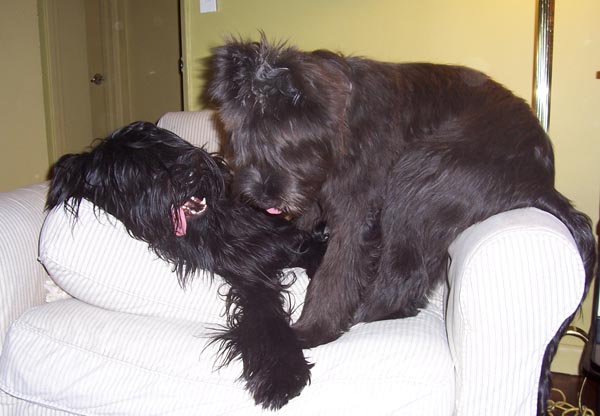
This is not a
dog that should be tied out. Briards can and will become very
frustrated if they are tied out or left in the backyard while
you are at work, invisible fences are not ideal. A good 4 to 6
foot fence makes for a good neighbor. A good rule of thumb is
if you are not at home your Briard should be in the house. Things can
happen that you are not aware of that can cause your Briard to
behave badly if left outside. Keep your Briard safe. They are very agile dogs
and they are protective of their territory.
There is a very
common joke among all Briard owners, that once you start living
with a Briard - you never ever enter a bathroom alone.
True. When you
stand at the sink they often lay right behind you, when you are
watching TV or reading a book they are laying on your feet.
Even when in deep sleep, they will feel you leaving the room and
will wake up to sleepily follow you.
Briards like to
be part of everything you do and they will often follow you from
room to room as you move around the house. They are shepherd's
dogs and as such, they are innately programmed to be aware of
the shepherd's comings and goings. These dogs will most likely
try to join you in your bed at night, or at least at the foot of
it. Being separated from you feels like a punishment to them, so
if you do not like a dog who will poke his nose into every
little part of your day - this breed is not for you.
Most Briards are
not couch potatoes and require a decent amount of exercise. They
will be happy to lay at your feet at home, but only after they
have released some of their energy by playing 'catch the ball' with you or
taking a good long walk. If left without physical activity for
too long, they may take their frustration out by remodeling your
furniture or shoes. A good Briard is a mentally and physically
exercised dog, in other words - a good Briard is a tired Briard. |
|
|
|
Briard Coat |
|
Now here is an interesting subject....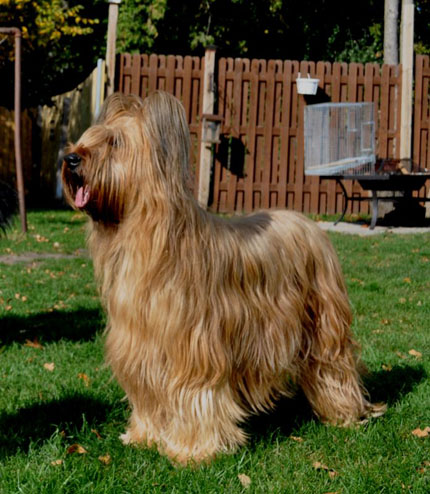
Briards were bred for farm work. They were
meant to roam the fields and occasional woods in all kinds of
weather. Their coats are supposed to protect them from heat and
cold, from scratches and injuries during the long hours while on
duty. Historically, these dogs could go on week long treks
leading the flocks to the summer pastures and then spend months
living there with the flocks and the lone shepherd. This means
that their coats are meant to be relatively easy to care for and
should not require frequent or very particular grooming.
In fact, many shepherds would
shear their Briards when they sheared the sheep twice a year.
Brushing a dog would not have been a task that shepherds
would bother with. So why do so many articles say that these dogs should be groomed
daily?
Good question.
Some of this added
coat care can be put squarely at the feet of breeders. Most
Briard breeders breed for "show" dogs, not for working dogs.
The standards state hair at the shoulder should be six-plus
inches long. Double that length is more common today. When we
choose dogs that are to be bred - hair length, among other
things, was and is an asset
that is much admired. Add to that dog nutrition which has
changed over the years. With "premium" foods come "benefits"
that include supplements for growing hair. When you look at
images of the breed from the early 1900's, the dogs' coat was
shorter and more "rustic" looking. When you compare that to the
long coat that is much more common today - the difference
is apparent. Click on the following link or the image below to
see more Briards of the past.
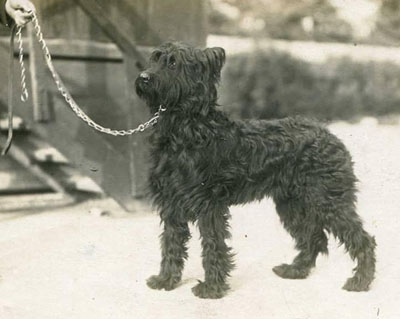
Briards are a
double-coated breed. They have the long hair that we call 'guard
hair' and the undercoat. Their guard hair, if proper, should
resemble coarse goat hair while the softer undercoat should be
present but not be overabundant. When you see a good Briard
coat - you should be able to see shiny thick hair strands, not
unlike the thick, supple, luxurious hair on some human models
advertizing shampoo. The coat should not look fuzzy, frizzy,
flyaway or have the look of cotton candy. A good coat will
require weekly or bi-weekly brushing and it will not mat much
and will not require much bathing. The guard hair falls out like
human hair, the undercoat is the real matting culprit. Briards do not
shed like goldens, newfs, shelties. You don't have hair all over
your clothes, and furniture. You may have some hair/dust balls
gathering in the corners of your home, but that is all. . .
When a Briard is
a puppy, many folks neglect training the puppy to be groomed,
because pups don't really mat. Then, suddenly, the day comes
when they start to blow their puppy coat. Your no-mat youngster
goes from wash and wear to a clumpy lumpy mess. This is the
time which most experienced briard owners welcome and dread.
The adult coat is coming in but the baby coat is "shedding", and
you have to groom to get that soft undercoat out. Once you are
through with the puppy coat, you settle into the adult Briard
coat. Adult Briards will go thru occasional periods when they blow their
undercoat more than usual; this can happen during the changes of seasons, or a
female may blow her coat after she has been in season, or any Briard can blow coat after surgery.
A good adult
Briard coat may require some thorough raking to remove excess
undercoat, but if done properly will not
be necessary to do it more than 4-6 times a year. Proper
Briard coat has a hard cuticle and structure which helps repel
dirt and thus does not require much bathing. Even when rolling
in the mud, once dry, the proper coat will shed dirt and sand.
Unfortunately, all the drying debris may often be shed on your
floor and furniture. They can be like a dirty dust mop that has
not gone outside to shake. Many Briard owners are big consumers
of Swifters. Dusting can become second nature. If you bathe a
Briard with a good coat after about 2 months of playing in all
types of weather - the water will run relatively clean.
When the coat is improper - you may need to
groom the dog daily or every other day. Every walk in muddy,
wet weather may require a bath. Such coats do not release dirt
easily as it gets trapped in the over abundant cotton candy
undercoat and gets plastered to the skin of the dog. If left
unattended - it will eventually result in hot spots or some
other skin irritation.
If you bathe a
Briard with an improper coat after about 1 week of playing in
all types of weather - the water will run muddy.
Unfortunately such coats do exist in some
lines and you need to make sure that you understand how to tell
the difference when looking at the dogs. Some people like daily
grooming of a large canine. If you are not one of them, pay
attention to the coat in the family of Briards from which you
are getting the puppy. And remember: being a Champion does not
prevent the dog from having an incorrect coat. Show dogs are
presented to judges bathed and groomed, and not every judge is a Briard coat specialist.
Can you tell the difference between the
texture of coat on the Coat types A and B below? Please ignore
the color and shape of the dogs. The images have been edited to
disguise the actual dogs and are meant to show only coat
texture. The two coats shown in the Type B pictures are not easy
to care for and would be considered not proper for a Briard. The
coats in the Type A pictures are coats with proper texture.
|
|
Coat type A |
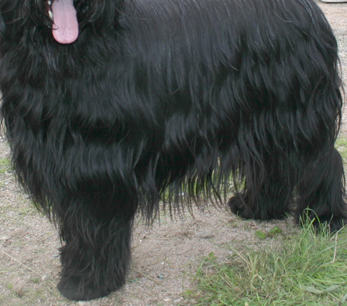
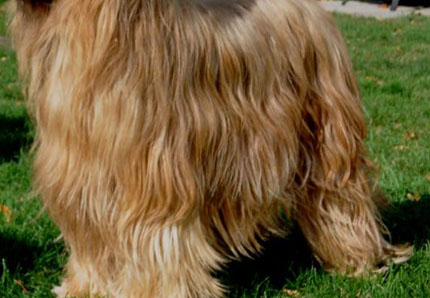 |
|
Coat type B |
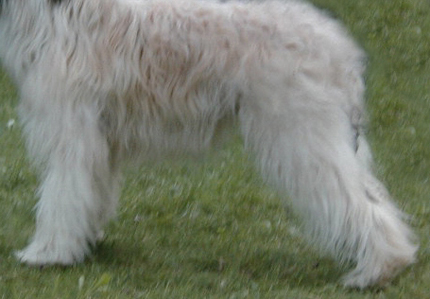
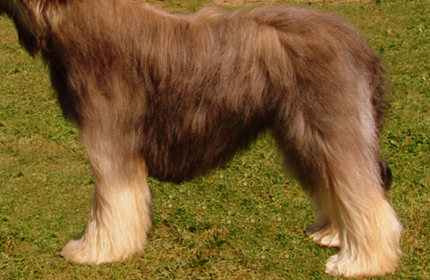 |
|
Some people choose to shave their Briards and
not deal with coat care. Briards need some of their coat
for protection from inclement weather, but a puppy cut is more
than adequate for that purpose if the coat is too much trouble
to deal with. Many owners choose to give puppy cuts to their
older (10 and up) Briards, because as these dogs age they become
less enamored with jumping on the grooming table.
An adolescent Briard coat does require more
frequent grooming when the coat begins to change from baby to
adult, but once that growing stage is over -
Briard coat care
should not be a full time job. This 10 year old female was last
groomed about 5 weeks before this picture was taken. You can see
her wet feet after she was playing outside in the mud and
melting snow for an hour. She has as close to a care-free coat
as a long coated dog can have. Her coat quality was noted and
highly praised during 'Selection' in France.
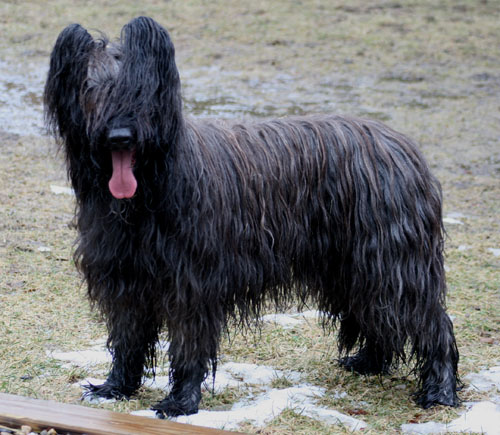
|
|
|
|
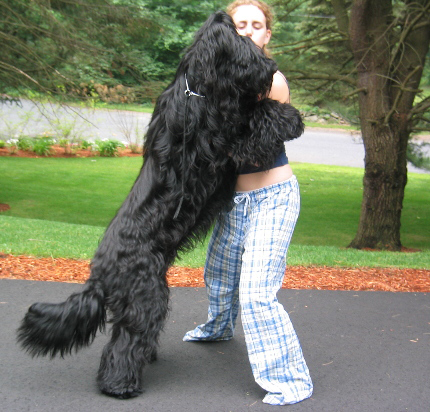 Size
Size
From the standard:
Size, Proportions
'Size--males 23 to 27 inches at the withers; bitches 22
to 25½ inches at the withers. Disqualification--all
dogs or bitches under the minimum. Proportions--the
Briard is not cobby in build. In males the length of the body,
measured from the point of the shoulder to the point of the
buttock, is equal to or slightly more than his height at the
withers. The female may be a little longer.'
This means that a Briard is a large breed
dog who grows up from a one pound newborn to a 60-100 lb animal
within the first 18 months of its life. This also means that you
have very little time to teach your puppy how to behave and not
jump on you and your visitors before the young dog is large and
powerful and can easily knock a human over.
Briards are very well aware of their large
bodies and tails and rarely knock something over without
intending it, so they do very well in small living spaces
surrounded by many nick-knacks, but they need to be taught what
is off limits and what they should be careful with. Look
at the age progression in the two images below: what a
difference 10 months makes in a life of a Briard puppy. |
|
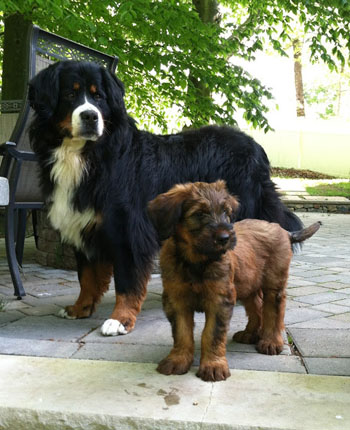 |
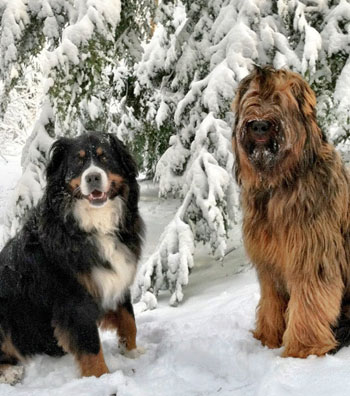 |
|
|
|
Are Briards costly to own?
As many other large breed dogs, a Briard is not
a low budget proposition. They eat like large dogs do, they
require regular grooming like long haired breeds do, they
require training like protective breeds do and they require
medical care that will
often cost more than a small dog. When you go away on
vacation, they are harder to leave in a kennel, unless they are
really well socialized and know how to play well with other
dogs. The initial cost of a Briard puppy - is
only the small drop of what living with this dog will cost you.
|
|
|
|
Relevant resources
coming soon....
|
|
May not be reprinted or used in its entirety
or any part without the express permission of the author.
|
|
Yes. I still want a Briard. What now? |
Since the previous article was not able to talk
you out of getting a Briard, let's talk about how to look for
the one for you.
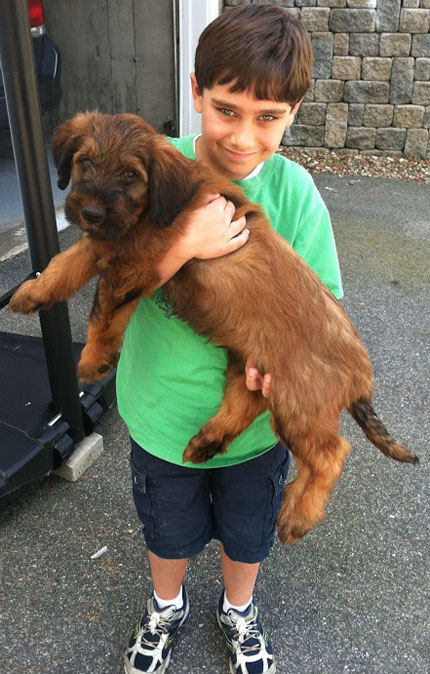
Step One, find a Briard breeder. But how do
you find that right breeder?
You should talk to many and see with whom you you click mentally and emotionally. Remember, this is not a
one-time limited transaction,
like buying a car. It is more like getting a new in-law.
That breeder, if it is a caring breeder, will
have a 'relationship' with you for the life of your puppy. Most
such breeders sell puppies with a contract that requires you to
keep in touch and also requires you to return the dog to them if
you are no longer able or willing to care for it, or at least
place the dog in a mutually agreed upon home. When
you talk to a breeder make sure that you give the breeder
as much information as possible about your lifestyle and what
you are looking for in your dog. The more information the
breeder has the better match the breeder will be able to make.
If you found the ad for
a 'perfect looking' puppy online, do not rush. Talk to that
breeder. Do your research. Ask about the pedigree of the litter
and look, really LOOK, at the names on the
pedigree for at least 5 generations. Every good Briard breeder
can point you to a pedigree online. Championship attached to the
name is great, but what is MORE important to you as a puppy
buyer is - what kind of breeding program does this breeder have?
How much inbreeding is there? How often is the same bitch bred?
What did the relatives die from? How long did they live?
There are some breeders out there who are
successful in the show world by marketing their dogs well, but
they stick to the idea of
close inbreeding. They breed generations of very close relatives
(uncles to nieces, brothers to sisters, mothers to sons,
etc..) in order to produce
dogs that consistently LOOK a certain way: have the 'line look'.
There is a huge difference between
the 'line look' and the 'type look'. Line look, is what makes you
clearly recognize the dog as not just a typical Briard, but a
member of a particular family. That is usually achieved by close
and consistent inbreeding.... Type look - is when a Briard looks
as a dog described in the Briard standard.
Unfortunately, there is a high price to pay for
that 'visual consistency' of the 'line look' and that price
often can be the health,
temperament and longevity of the dogs. To better understand what
it means, please read the following below article by Dr.
Catherine Marley. She explains simply and clearly what
inbreeding does to dogs.
|
|
|
|
Genetic Diversity - the Dark Side of Inbreeding |
Genetic Diversity - the Dark Side of Inbreeding
written by Catherine Marley, MD
Kai-La-Sha Lhasa Apsos (http://www.lhasa-apso.org)
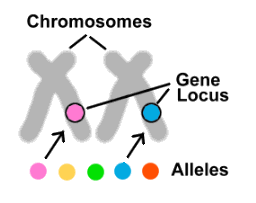 If
you can imagine building a house, there are numerous
subcontractors working on it, the framer, the electrician, the
plumber, the bricklayer etc. Now each worker gets two sets of
plans for his part of the job. Of course there are a number of
other sets of plans or blueprints for this kind of job back at
the main office, but for the job in this house, the worker only
gets two of the many possible plans. If
you can imagine building a house, there are numerous
subcontractors working on it, the framer, the electrician, the
plumber, the bricklayer etc. Now each worker gets two sets of
plans for his part of the job. Of course there are a number of
other sets of plans or blueprints for this kind of job back at
the main office, but for the job in this house, the worker only
gets two of the many possible plans.
A gene is like a long blueprint given to the
subcontractors in the body. If there is a mistake in the
blueprint, the worker either does the job incorrectly or he
doesn't finish the job. All the possible plans (or genes) that
one might use for a particular job are termed alleles. In
this case, the worker gets two sets of plans (genes) of the many
possible ones (alleles), and he puts one set in each hip pocket.
If one of these sets of plans gets damaged, the worker still has
a good set, and the work can proceed on schedule.
The pocket is the analagous to the "gene locus". The
locus is an actual location on each of a pair of chromosomes in
the cell. Each cell has multiple pairs of chromosomes, - the
number is species specific. Each chromosome contains many loci
for all the jobs that have to be done in the body. There is
one allele, specific for each job, residing at the identical
locus on each of a pair of chromosomes, - just like the two
sets of blueprints in the worker's hip pockets. The animal got
one set of those paired chromosomes from each of it's parents.
In the carrier state of a recessive genetic mutation, the animal
has gotten one good copy of the gene in question, and one
defective copy. In this case, one good copy is sufficient for
the work to proceed and the animal to be healthy.
Genetic diversity in a population means that the
population contains most of the possible alleles (alternate sets
of plans) for a particular gene locus rather evenly distributed
throughout the population. (Of course an individual animal can
only have two of those alleles, for every gene locus, in his or
her private collection.) This is where you start getting into
trouble in an isolated population, such as in quarantine
countries, or in very small countries. A very popular stud
arrives in the country. Soon every bitch in the population is
bred to him. Suddenly every puppy in the country has one or
the other of his alleles for every gene locus. This would be
bad enough in itself, but even worse, by breeding every bitch to
the one male, you have selected AGAINST all the other
alleles in the adult male population. These alleles will
disappear unless they are handed down to offspring. This is
genetic death. (death before having a chance to reproduce).
Genetic diversity has been lost.
Let us suppose that there were 200 males, and 200 females in
our hypothetical breeding population. But all 200 bitches were
bred to Mr. Wonderful. Now, instead of having 200 different
paternal gene collections represented in those 200 litters, we
have only one. Now someone says, "We got such great type from
this dog, let's breed his daughters to him as well." Now you
are throwing away another whole set of alleles.
Even assuming Mr. Wonderful is perfect - an unlikely event
that he carries no hidden defective alleles, since the average
is around 7, many alleles carried in the former population have
been ruthlessly discarded by overusing Mr. W. We have no idea
what they are until something bad happens in the population.
For instance, some genes MUST be carried in a heterozygous
state for the animal to have an intact immune system. In an
inbred population, this heterozygosity is lost. Modifiers that
keep otherwise bad genes from being expressed can be lost. Genes
responsible for subtle changes in longevity or fertility can be
lost. Numerous studies have shown that declines in fertility
are directly linked to the degree of inbreeding. So even Mr.
Perfectly Wonderful is dangerous if he becomes the father of the
majority of a population!
Now suppose this dog carries a hidden defect. In the first
200 litters sired by Mr. Wonderful, one half of the pups are
carriers of that same gene. In selecting for the gene set that
this dog carries, you have selected FOR the defective gene,
and AGAINST a "good" one which may have been in the
population before Mr. Wonderful came along.
Lets say that by now, (which is usually the case in popular
sire effect), the overall carrier rate for the bad gene is
50%. This means that every other animal in the population
carries at least one copy of Mr Wonderful's defective gene. The
chances are 1/2 that any dog carries it and 1/2 that any
bitch carries it. The chances are 1/2 x 1/2 or one in 4 that
two carriers will be mated, even if we bred them randomly. But
by now Mr. Wonderful's "look" has become a showring necessity.
In all likelihood, we will be selecting, for our breeding, that
dog and bitch who look most like Mr. Wonderful. The very plain
pair have been neutered and placed as pets.
Again we have selected for the genes of Mr. Wonderful
and against the other genes in the original population.
But the pair resembling their famous sire are the very ones most
likely to be carrying the heaviest helping of Mr. Wonderful
genes, both good and bad. So the chances are that more than 3
out of four litters will produce carriers, and one out of
4 litters will now have affected puppies. In each of
these affected litters, 3 out of 4 pups will carry the defective
gene. Only one in four pups in each of these litters will be
"clean".
What is the solution? The most obvious response is
"don't breed any dogs carrying that gene". Now suppose we
decide we will not permit breeding of affected dogs or carriers.
Abruptly, we eliminate from our breeding the the 50% of the
population which carry the defective gene. Which dogs are most
likely to be carriers? The ones that look like Mr. Wonderful, of
course. What is now left in this genetically decimated
population? Precious little, perhaps not enough to go on with.
There may be genetic problems that have surfaced because of the
lack of "good" genes in the population, neonatal losses, failure
to thrive, allergies, etc.
What happens, on the other hand, if we outcross to a
line which has never had this problem? Suppose we assemble a
number of unrelated dogs, - lets call them all "Mr.Clean" - and
breed each of our bitches to a different Mr. Clean. Again 1/2 of
the bitches which are bred to our Mr.Cleans, are carriers. This
means that they have one "bad" copy of the gene, and one "good"
copy. Since the sires have only good copies of the gene, half
of the pups from the carrier mothers will be carriers, but NONE
will be affected. In a late onset disease, identifying
affected animals before they are bred will be a problem, but
testing for the disease before breeding will reduce the number
of litters an affected animal is likely to have. By using
mainly outcrosses, even the accidental use of affected dogs will
not increase the prevalence of affected offspring.
What about other problems? If this group of sires carry
undesirable traits, they will each have a different collection,
- alleles different from the inbred population and from each
other. The likelihood of two "bad" copies of any gene getting
together is thereby markedly reduced. And this infusion of new
genes has introduced new genetic diversity into the impoverished
line.
Put these two approaches together. Let's say we do not
intentionally breed any animals who carry two copies of the
defect, and we only use known carriers when there is
a good reason to do so, and then ONLY to unrelated animals.
This approach allows the gradual removal of the defective gene
from the population, and the preservation of most of the good
qualities of good old Mr. Wonderful. It restores a healthy
degree of genetic vigor to the population, and lessens the
likelihood that other "bad" problems will manifest themselves.
This is what the "genetic diversity" approach to breeding is
all about. The "wholesale genetic slaughter" method may be
appropriate in a genetically diverse population with only an
occasional individual case of the disease in question. (Of
course you rarely have this kind of problem in a genetically
diverse population.) You get into the heavily "loaded" state
only by inbreeding. Using the "wholesale genetic slaughter"
method, even if it were practically possible, will not cure the
problem in this inbred population, because the real culprit
is not the defective gene, but the inbreeding. Besides you
have to wonder what you will have left when you are finished.
The dogs are still inbred, with all the problems that go along
with inbreeding. In fact, they are twice as inbred as when
you started, because you threw away half the genes. You
won't have much of the genetic disease you select against, but
maybe you won't have dogs either.
A reasonable course of action in any genetic disease
demands that attention be paid both to removing the gene where
possible without seriously degrading the genetic viability of
the population, and taking steps to provide increased genetic
diversity if it is needed. |
|
back to top |
|
Dog Safety - An Ongoing Job |
|
Dog Safety
- An Ongoing Job
By Becca Weber
Just like any job there are good days and
there are bad days. While many things seem to be common sense,
others aren’t so cut and dried.
Twenty-five years ago my husband and I
skipped our honeymoon so we could attend our first dog’s
graduation from his first obedience class. We entered the class
still carrying the euphoria from the wedding. The excitement
faded when we were told that the Collie who had been in the
class had gotten her head stuck in a potato chip bag and
suffocated while the owners were not at home. It sounds like a
bad joke, but it was a devastating reality.
We’ve heard about disastrous, and near
disastrous, leaps dogs have taken from parking ramps. I know
one dog who survived only because he was wearing a leash and the
owners risked their lives to save him. Dogs lose limbs and even
their lives from getting trapped in partially/improperly closed
crate doors. I’m a huge advocate of dogs wearing collars
containing ID and contact information – when I travel.
My dogs each have a microchip, but their ID tags provide my
vet’s phone numbers to anyone, in case of an emergency. I do
not leave collars on the dogs when they are at home. I never
leave choke chains on a dog unless it is being trained.
Several years ago, a co-worker came into
work with his face bruised and sutured. He’d been babysitting
the littermate to his Golden. The littermates were playing and
one became entangled in the others choker. What had begun as
play turned into a fight for freedom. My friend tried
untangling them and sustained numerous bites and more than sixty
stitches. Only after one dog had choked to death was he able to
separate them.
Our dogs can be incredibly intelligent.
Despite their domestication they are not programmed to
understand all the things humans have invented. We’ve built a
world where we must accept fuller responsibility for their
welfare and even their decision making. Quite often the most
important thing we can do for them is to completely remove them
from situations where the dog may feel the need to make a
decision. While this opinion may sound overly controlling, its
necessity is a sad reality.
I believe most dogs should be safely
confined to a crate or an inside run when they are left alone.
Crate training done properly teaches dogs to enjoy and
appreciate their own personal space. Crates should be in good
condition with no jutting wires and no cracked pans. By
controlling their environment while you are not there, you are
controlling their behavior. Even a perfect dog may feel ill
enough to try and use the fabric of a rug to settle their
stomach. Another good reason to properly crate train a dog is
to prepare them to find comfort in confinement in case it ever
requires hospitalization.
Many of us travel with our dogs. Always be
sure that your cargo is secured and that any bungee cords near
or on their crates are attached with the open end of the hook
away from the dog.
Keep your eyes and your minds open to any
potential danger or risks. It may save your dogs life some day. |
|
|
|
Understanding and Maintaining Pack Order |
|
Understanding and Maintaining Pack Order
By Becca Weber
Dealing with the Dominant Dog
Understanding the need for pack
order and owner dominance is not always easy, but is absolutely
necessary for peaceful, uneventful, long term ownership
of a dog. While this is necessary for some breeds of dogs more
so than others, and indeed, some individual dogs more so than
others, every dog can benefit from understanding it's exact
place and role in the pack order within the home.
The "pack" includes every living being in the home;
i.e. humans, dogs, cats, birds, etc. Some of the leading
causes of children being bitten by a dog include dominance
aggression, aggression based on sibling rivalry, and even
possessive aggression. All three of these issues can be
avoided, even eliminated, by simply establishing and maintaining
a well-defined pack order.
Through more than twenty years of training dogs, I have found
that the majority of those who come to me for help with their
dogs come because the dog is showing aggression. In most of
these cases the dogs are exhibiting the three types of
aggression as stated above; dominance, sibling rivalry, and
possessive aggression. The less common types of aggression
include fear aggression, and even less common, is what is known
as idiopathic aggression - cause unknown.
Of the dogs exhibiting definable forms of aggression, the
treatment success rate can be outstanding. The only reason most
failures may occur, is the inability, or unwillingness of the
owner to stick with the treatment and prevention plan. Some
owners do not believe the some times 'unorthodox' methods of
treatment will work. Others feel it is "not fair to the dog."
These owners are wearing blinders that allow them to see only
what they want to see, until their path leads to euthanasia, or
the surrender to the shelter. These same people seldom give the
shelters the true reason the dog was rendered, thereby passing
the problem onto someone else.
Let's look at the dominance aggression. Subtly is one the
strongest forms of dominance, often not displayed through actual
aggression until the dog's dominance is thwarted in an
uncontrolled, sporadic manner, whether by it’s owner, or other
animal in the home.
Seemingly
harmless acts, such as charging through doors ahead of owners,
getting on the bed before the owners do, then grumbling when
asked to move, if asked at all, jumping into the car as soon as
the door is open, etc, are subtle signs of dominance..
Missing these signs, or
responding to them in a defiant manner, can often induce the dog
to import more drastic, less subtle means of supporting its
self-assigned dominance. To the dog’s thinking, the subtle
signs of dominance may no longer be enough. The dog may begin to
resort to dominant stares, 'smiles', and even aggressive
charges.
The minute a person misses a dominant stare, misinterprets or
ignores the 'smile', backs down or cries out at the dominant
charge, the dog has gotten his point across. He/she feels they
have adequately informed you of their dominance.
When this dominant play is directed at a youth, and the adult in
the household then disciplines the dog, the dog's dominance
aggression can be compounded by the addition of sibling rivalry,
and possessive aggression. The dog may resent the human
interference into to what has otherwise been his domain.
Unless very specific ground rules are set up and maintained
without exception, this dog's attempts at dominance may, and
probably will, increase. Disciplining a dog for inappropriate
behavior is understandable, and certainly the dog should not get
off Scott-free. However, physical discipline does not impart
the dominance structure, or pack order, that you are trying to
build. It may only increase the frequency and intensity of
the dominant overtures.
This dog must be taken back to step one.
Rule #1. He/she is a guest in your home. The dog will
live by your rules, and oh boy, do you have a lot of
rules. The dog will now have to work for everything which
had previously been given free of charge. (This includes meals,
walks, going outside to do their duty, the right to lay near
you, the right to go for a ride in the car, the right to visit
with household company). Everything must be earned!
You are the alpha. The dog is always the bottom rung on the
ladder. Always!! The dog, of course, will not agree.
After all, you have, until now, accepted or missed every signal
of dominance that he has displayed. While these methods will
differ in a multi-dog household, they would differ only
slightly. Humans always come first, then canines.
For the purpose of this article, we will assume the dog is in a
home with an additional dog, and 2 children. The dog
attempting dominance will be called Boss (she is going on
three). The other dog in the household is named Sandy (she is
six). There are a mother, a father, a son (7), a daughter (3),
and the two dogs.
Sandy is perfectly happy being left out of the controlling order
of things. She, herself, is not a threat to anyone's
hierarchy. She is, however, a critical part in the treatment of
Boss.
Boss is beginning a new lifestyle. Boss is about to loose every
right, every privilege that he has ever known. Even those
rights and privileges that you were unaware of. You are about
to become a major control freak. Keep in mind that once the
dominance structure has been established, life will begin to get
easier and happier for Boss, as well as the family. Sandy will
not notice any difference. She will just continue to go along
her happy way.
Boss will be assigned a corner of the living area, an area that
is out of the line of traffic, and away from where family
members will be most likely to be relaxing.
Obedience training is next. Boss must know the down and the
stay command in order to enforce the “Rug” command. The dog
must learn to sit, stay, down, to 'rug,' and come on command.
(Rug means retreat to designated area as discussed above, lie
down and stay there until told otherwise. Boss will not be
allowed to have any toys in his rug area. Think of it as Boss's
time out area.)
Every toy Boss had no longer belongs to him. Sandy may keep her
favorite toys, but Boss will no longer have the right to choose
which toy he will play with. You, the control freak that you
are, will tell Boss which toy (1) he may play with. It will not
be his favorite, and he will not get to play with it until he
has done something to earn it. Then, again, control freak that
you are, you will not let him play with the toy for nearly as
long as he would like. You will be taking it away from him and
sending him to his 'rug.' You will come to love this rug. I
guarantee it. Oddly enough, so will your dog. It will become
his safe zone, the place where he can do no wrong, the place
where he will be allowed to be with his family. He can observe
all, yet not have the ability to interfere, or attempt dominant
activities.
Suddenly, his nighttime freedom
privileges have been revoked. He is placed in a crate at
night. Put to bed before dear Sandy, even before the kids. Put
to bed without fuss, without ceremony, and without food, water
or toys left in his crate.
Boss, if previously free fed, is now fed in his crate, after
dear Sandy, and after the family has eaten breakfast, and
dinner. Boss will have to perform a task in order to earn his
meal. Sit, down, rug, down, etc. Anything, so long as you are
being bossy. Dear Sandy may continue her eating schedule as
she's always done. Poor Boss will be given a designated amount
of time to complete his meal, maybe 5 to 10 minutes. Then his
dish will be removed.
When going outside, Boss will have to sit and wait until given
permission. Dear Sandy, of course, may go outside first. Boss
is not allowed to go outside to play with the children at
this point. To do so would allow him too many precious
opportunities to try and usurp your efforts at teaching him that
he is a 'nothing' in your household. All Boss would have to do
is cut in front of Sandy or either of the children just one
time, causing them to change direction, and you will have
suffered a major set back, while Boss celebrates a major
victory. This simple kind of victory will be enough to
encourage Boss to try again.
A simple rule of thumb, is "Boss is last." Last outside,
last inside, last to eat, last in the car, last out of the car,
(he should be crated in the car, if space allows) last to get a
drink of water. In fact, if Sandy is getting a drink of water,
and Boss cuts in, you will have to get Boss out of the water,
and onto his rug. He must wait until Sandy is finished. If you
have had to rug him, then he will have to wait until you release
him from his rug, before he can get a drink of water.
During meals, Boss is required to Rug. If you are in the living
room, and Boss is lucky enough to be sitting near you (he had
better have earned the right!) and a family member, or Sandy
enters the room, then poor Boss automatically loses his special
spot. You will tell him to rug, freeing the space by your side
to those higher on the totem pole. This is especially important
with the children. The children must be perceived as higher in
the pecking order. Children are allowed on the furniture, Boss
is not. Children sleep in their bed. Poor Boss isn't ever
allowed on one.
You will notice that none of the
above requirements include physical punishment. Pain often
increases aggression. Dogs communicate through body
language and through deeds. Something as simple turning your
back on a dog will have a specific effect. Growl at a dog, they
understand. Snap at a dog, it's an even clearer message.
Leaning over a dog with a "smile" on your face. All of these
are dominant actions understood by a dog. A dominant dog will
mouth the muzzle of a submissive dog. This too can be done to
remind a dog of who is truly dominant. Children should never
use these dominant actions, as most often they are too small,
and lack the experience, the strength, and the reasoning to
effectively execute the challenge and win.
When walking the dogs at the
same time, Sandy is allowed to walk ahead, if you wish. Boss,
of course, is expected to stay obediently at your side.
This is one of the instances in
life when it is best to nag, nag, nag! Pester, pester, pester!
Drive them nuts with commands and orders, as long as you
follow through and make sure they obey them. Control freaks
are necessary in any home with a dog; especially when the
dog is trying to become the dominant member of the household.
|
|
back to top |
|
BRIARDS AND KIDS |
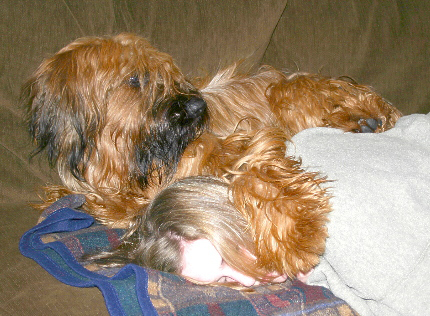 This article is coming soon....
This article is coming soon.... |
|
|
|
Show Dog? |
|
Requirements for
the American Championship for a Briard:
-
A dog has to be
registered with AKC on a full (not limited) registration and
be over 6 month of age.
-
A dog has to earn 15
show points. Each point is earned based on the number of
dogs defeated at each show. Points/dogs defeated ratio
varies depending on the state where the show is held. In
some states 5 or more dogs defeated – give you only 3
points, in others it is a dog per point. This is established by the AKC based on the historical data of the
number of dogs of your breed of each sex shown in each state in previous years.
-
Each set of points must
be awarded by different judges.
-
The 15 earned points
must include at least 2 majors awarded by 2 different
judges. A major is 3 or more points awarded in the same
show.
-
A maximum amount of
points that can be earned in one show is 5. So the fastest
way a dog can become a Champion in the US is by winning 3
five- point majors. Not very often, but this theoretically
can even happen in one big show weekend, if a dog is shown
for 3 days in a row and wins all three days. Males and
females compete separately, but either one can receive the
points earned by the opposite sex by defeating the opposite
sex competitor as the “Best of Winners”. So, for example:
let’s say the show has 1 female and five males for a 3 point
major. Let’s say the female defeats the “winner male” in the
end, In that case both “winner bitch” and “winner male” end
up winning equal amount of points. This is called “splitting
the major”.
-
There are no required
health clearances. There is no time limit on earning the
points. Ears can be cropped or natural. The requirements are
the same for all breeds.
|
|
Requirements for
the French Championship for a Briard:
In France the requirements are very different.
:
Requirements are Breed specific. For the
BRIARDS, in order to become a champion one needs the following:
-
Health requirements: CSNB and Hip Dysplasia
clearances
-
Temperament requirements: A proof of
temperament test passed at one of the required shows with
grade no less than 16. The
test is always offered at the National Specialty. Point
scale is 0 to 20. Here
is the scale (in French): 1-5 Intolerable; 4-7 Insuffisant;
8-11 Bon; 12-15 Tres Bon; 16-20 Excellent
-
Proof of full
Registration.
AKC registration is acceptable.
-
Scan of a Microchip.
-
Natural ears. Cropped
dogs born after 2003 cannot be shown.
-
Next, your dog has to receive a CACS at the
Nationale d’Elevage (the National Specialty) or the Championat De
France (The French Championship Specialty show). This certificate is
obtained separately by males and females. Each has to defeat
its own sex. The certificates are not obtained across sexes
(like “split majors” in the US). These certificates are
normally awarded as a result of your dog defeating same sex
competitors.
-
A
dog has to earn a CACS at the Regional Specialty. ( same
conditions as the Nationals)
-
A dog has to
earn a CACS in an all breed show. In some cases here, the
certificate can be obtained even without competition. If
there is no same sex dogs entered in your class at an all
breed show, your dog can still obtain the certificate if the
Judge finds your dog worthy of it. In that case, in the eyes
of the Judge the dog competes against the standard and is
judged that way.
-
Each
certificate must be issued by a different judge at an
international show in France.
-
Once your dog
has earned the first certificate you have 2 years to finish
the run for the Championship. If you fail, the certificate
becomes obsolete, and you have to begin the process over.
Here is what these
certificates mean:
CACS =
Certificate of Aptitude of Conformity for the Standard (Certificat
d'Aptitude de Conformité au Standard)
CACIB =
Certificate of Aptitude for the International Contests of Beauty
(Certificat d'Aptitude au Concours Internationaux de Beauté)
In France there are 6 or 7 specialities per
year, one Nationale and a Championship of France. There are
4 CACS issued per show, 1 CACS for the black
females and 1 CACS for the tawny females, 1 CACS for the black
males , 1 CACS for the tawny males. There are also
2 CACIB issued; one for the best male and the other for
the best female. And after, they have the BOB.
All certificates must be earned under 3
different judges, and it is enough to earn only the CACS
and not the CACIB
Realistically, in France there can be
a maximum 2 champions per sex and color per year as it is
limited by the four CACS that are issued at the National
Specialty and the four at the French Championship Specialty.
|
|
back to top |
|
Copyright 2013. Olga Shulman at Briard Breeder.
All rights reserved. |
|
